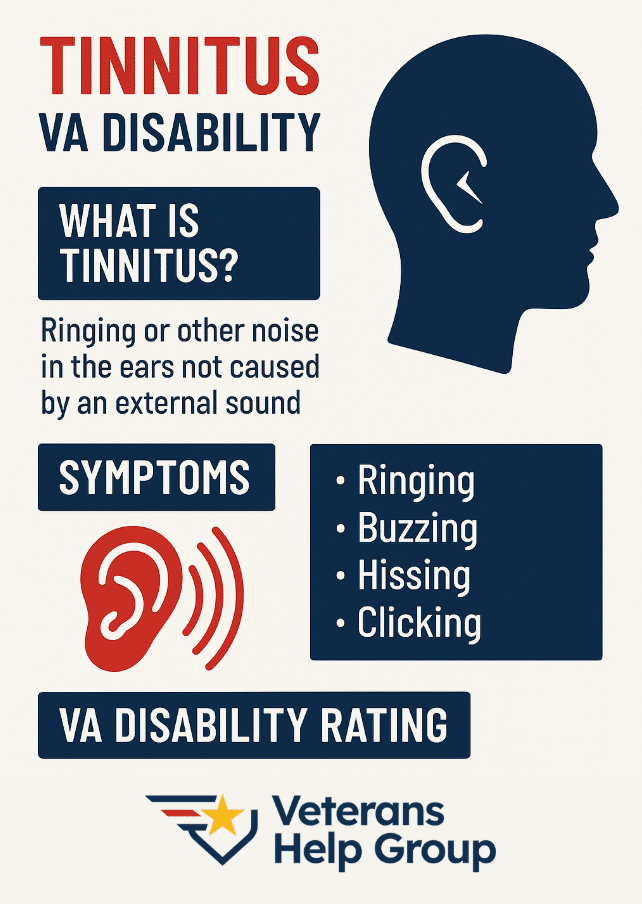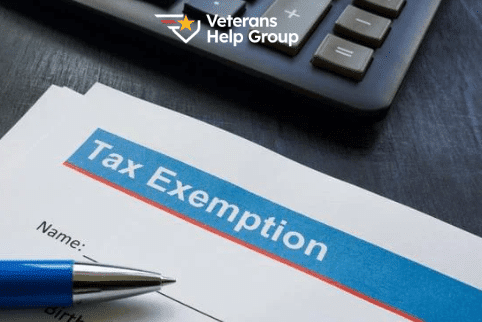
Table Of Contents
2025 VA Tinnitus Changes
For years, the tinnitus VA disability rating has been set in stone. If a veteran suffered from compensable tinnitus, they were assigned a 10% VA disability rating. That rating carries with it a small monthly monetary benefit–in 2025, $175.51/month. The veteran also receives VA healthcare services for the service-connected condition.
However, the VA has proposed significant changes to that rating system, which experts anticipate will take effect in fall or winter 2025. These changes could dramatically impact thousands of veterans who rely on tinnitus as their primary or gateway disability claim.
Understanding Current VA Tinnitus Benefits
Under the existing system (Diagnostic Code 6260), tinnitus receives a flat 10% disability rating regardless of:
- Whether it affects one or both ears
- The severity of symptoms
- How much it impacts daily life
This makes tinnitus unique among VA disabilities, as most conditions have variable ratings based on severity.
How Will the Tinnitus VA Rating System Change?
The 10% standalone tinnitus VA rating will be largely eliminated when the proposed changes take place. Tinnitus will be evaluated when assigning a hearing loss VA rating, and will be assessed under the hearing loss criteria. A veteran would be entitled to the standalone 10% tinnitus rating in only one circumstance, when the veteran received a 0% VA disability rating for hearing loss.
New Evaluation Framework
Under the proposed changes using Diagnostic Code 6100:
You CAN Still Get a 10% Tinnitus Rating when:
- You have service-connected hearing loss rated at 0% (non-compensable)
- The tinnitus must be medically linked to the hearing loss
You CANNOT Get a Separate Tinnitus Rating when:
- If your hearing loss is rated 10% or higher
- If you have no underlying service-connected condition
- Tinnitus will be considered part of the hearing loss condition and not rated separately
What Does This Mean for Veterans with Tinnitus?
The most immediate thing veterans should know is that, at least under the current proposed change, veterans who already have a 10% tinnitus VA disability rating will not be affected. If you are considering pursuing disability benefits for tinnitus, you should act quickly. If you’re able to secure a VA disability rating under the current system, the change won’t apply to you.
For those who pursue benefits later, evaluation for hearing loss will be critical, even if you believe the loss is minor. If your hearing loss is rated 10% or higher, your tinnitus will be rolled in. But, if your hearing loss is rated at 0%, you may still receive the flat 10% rating for tinnitus.
You will also want to ensure that you fully consider any other possible service-connected or secondary-connected conditions. If you secured a standalone rating for tinnitus prior to the change, you can still file claims for conditions secondary to tinnitus. Even if you are pursuing your disability rating later, other conditions secondary to hearing loss could increase your VA disability rating.

Top 5 FAQ About VA Disability for Tinnitus (2025 Update)
1. What’s the VA rating for tinnitus?
Tinnitus is rated by the VA at a maximum of 10% under Diagnostic Code 6260. This applies whether the condition affects one ear or both. As of 2025, the monthly compensation for this rating is $175.51. Since tinnitus can’t be rated higher on its own, many veterans will get Tinnitus connected to secondary conditions to increase their total disability rating.
2. How can I prove that my tinnitus is service-connected?
To receive VA benefits for tinnitus, you’ll need to provide three key elements:
- A current medical diagnosis of tinnitus
- Proof of an in-service event, injury, or exposure
- A medical opinion linking your tinnitus to that service-related incident (called a “nexus”)
3. Is it possible to receive more than a 10% rating for tinnitus?
While tinnitus itself is limited to a 10% rating, your overall disability rating can increase if you file secondary claims for conditions caused or aggravated by tinnitus. These related conditions must also be supported with medical evidence.
Some common secondary issues tied to tinnitus include:
- Mental health conditions
- Sleep disorders like insomnia or sleep apnea
- Migraine headaches
- Meniere’s disease
If these conditions significantly impact your ability to work, they could contribute to a much higher combined rating, even up to 100%.
4. Are there changes coming to tinnitus VA ratings in 2025?
Yes. The VA is moving away from the standalone 10% tinnitus rating under Diagnostic Code 6260 and shifting to a new evaluation under Diagnostic Code 6100, which focuses on hearing loss.
Key points about the change:
- If your hearing loss is service-connected but rated at 0%, you may still qualify for a separate 10% tinnitus rating.
- If your hearing loss is rated at 10% or higher, tinnitus will be included within that rating with no extra compensation.
- Veterans who already have a 10% tinnitus rating can continue filing secondary claims under the old system.
5. What does a 0% tinnitus rating mean?
A 0% rating indicates that the VA recognizes your tinnitus as service-connected, but doesn’t find it severe enough to warrant monthly payments. Even so, you’re still entitled to free VA healthcare for the condition and reimbursement for travel to VA medical appointments.
Act Quickly if You Have a Claim for VA Disability for Tinnitus
If you believe you may have a VA disability claim for tinnitus, try out our VA Disability calculator HERE. You will then want to speak with an experienced VA disability advocate who can give you the most recent update about the timeline for the changes and your opportunity to secure a tinnitus VA disability rating before the change takes effect. An experienced advocate can also help ensure that you include all relevant claims and have the necessary documentation that the VA will be looking for.
To learn more, call Veterans Help Group today at 855-855-8992 or contact us here now.
More Veterans News Here:
Important PACT Act Update: VA Expands Presumptive Conditions – Easier for Veterans to Get Benefits
Dependency and Indemnity Compensation (DIC) Rates for 2025
VA Disability Payment Schedule for 2025
2025 COLA for Disabled Veterans

VA Disability Benefits and Tax Exemptions: What You Should Know
VA Disability Benefits and Tax Exemptions: What You Should Know Written by: Schuyler Swanton,...

Veterans Help Group In The Community
Veterans Help Group in the Community Written by: Bobbi Boudi, Director of Community Outreach, Amy...

The Veterans Appeals Efficiency Act of 2025
The Veterans Appeals Efficiency Act of 2025 Several bills are currently pending in Congress that...





